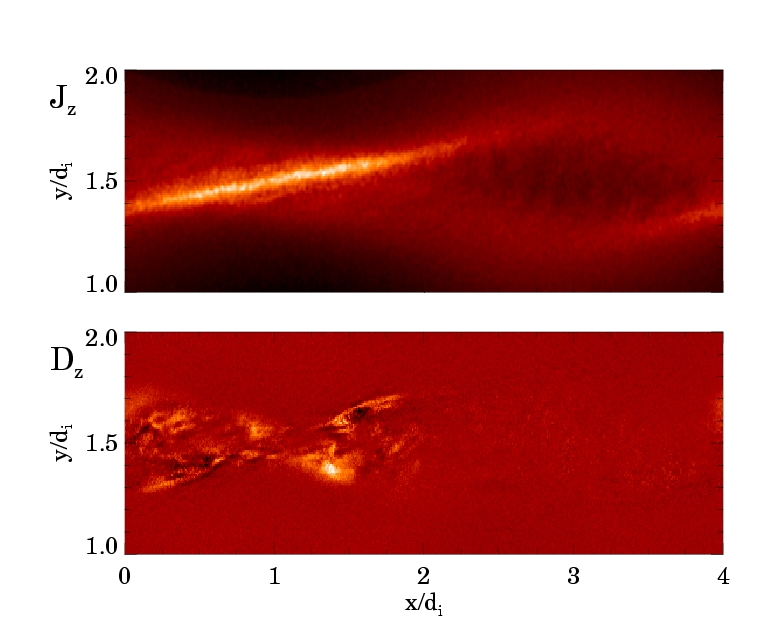|
Magnetic reconnection enables a magnetized plasma
system to convert magnetic energy into high speed flows, thermal
energy and energetic particles. It also connects field lines joining
previously isolated regions of plasma, allowing rapid transport of heat
and particles. The broad importance of reconnection in nearly all
plasma systems, ranging from laboratory fusion experiments to the
Earth's magnetosphere, the solar corona and the astrophysical
environment, render it one of the premier scientific topics in plasma
physics. The importance of this area is also linked to its intrinsic
scientific interest: the release of magnetic energy on a global scale
is linked to the topological change in the magnetic field resulting
from kinetic processes occurring at very small scales. Accordingly,
the understanding of magnetic reconnection demands the development of
innovative analysis methods which address physics coupling across
vastly disparate spatial and temporal scales. The absence of
techniques that can address such scale differences along with the
requisite physics -- kinetic models at short scale and MHD models at
larger scales -- has significantly complicated efforts to explore
reconnection at the first principles level, and as a consequence has
led to a failure to understand some of the most fundamental
observations in both fusion experiments and space and astrophysical
systems.
In the case of fusion experiments, magnetic reconnection phenomena
play a critical role in virtually every configuration which is being
explored to confine high temperature plasma. Indeed, three
reconnection phenomena can be problematic for burning and non-burning
tokamak plasmas: ``sawteeth'' can degrade confinement and expel alpha
particles from the plasma core; tearing modes (neoclassical or
otherwise) grow slowly and can lead to a loss of confinement and a
termination of the discharge; and disruptions can terminate the
discharge and cause damage to the plasma facing components. The
physics of even some of the most basic processes involved in these
reconnection phenomena is still elusive, e.g., the behavior of
the magnetic field profile (q profile) across the central plasma
core after the sawtooth crash. The inability to model the
reconnection of large scale flux and the evolution of magnetic
islands, while at the same time including an accurate kinetic
description of the currents and transport, is inhibiting the
development of a predictive capability to model the performance of
future fusion experiments such as ITER.
A broadly important issue, which spans fusion and astrophysical
systems, concerns the mechanism for intense plasma heating and
energetic particle production during magnetic reconnection. The
conversion of magnetic energy to energetic electrons and ions is
widely observed during reconnection in laboratory fusion experiments,
dedicated reconnection experiments, the Earth's magnetosphere and the
solar corona. Ions can be energized in the ion-scale boundary layers
and shocks that develop around the magnetic X-line and
separatrices. The elucidation of the mechanism for the production of
energetic electrons is a greater challenge, especially in the context
of large scale systems where the magnetic X-line occupies such
a small region of available physical space. Can electron acceleration
occur at sites far removed from the
X-line -- e.g., around the slow shocks that bound the
outflow region from the X-line?
In spite of the strong scientific evidence that non-MHD processes are
essential to model magnetic reconnection in laboratory and
astrophysical systems, the MHD model remains the model of choice
simply because the tools are not available to implement any other
model while at the same time resolving the huge range of spatial
scales involved. The scale separation problem is generic to
modeling reconnection in all plasma systems from the galactic to the
laboratory scale. In some sense the scale separation is a strength since
it permits some key simplifications which we will exploit. Examples are:
- The region where kinetic physics is critically important is
confined to a narrow reconnection layer typically a few ion larmor
radii wide -- the sawtooth problem being a notable exception
- The important kinetic scale turbulence evolves on a fast
time-scale compared to the the island growth time.
The description of multiscale systems is also now a very important
topic in applied mathematics and novel techniques such as projective
integration have been developed to model large scale systems in which
kinetic dynamics are of critical importance. Whether such approaches
can be applied to large scale systems undergoing reconnection remains
to be demonstrated. The techniques function best when the systems of
interest exhibit a distinct separation of spatial/temporal
scales. This is the case for the reconnection issues that are central
to the CMPD mission. Thus, joining forces
with experts in this emerging area of applied
mathematics to address this important multiscale physics problem
appears to be a very promising
path with the potential to
revolutionize the treatment of critical problems in reconnection both
in fusion science and the broader space and astrophysics context.
|

